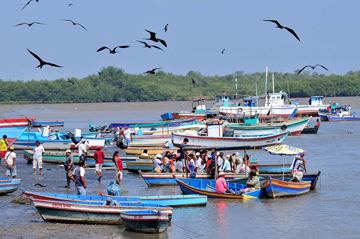
| Culture and people |
| Costa |
Peru has 28 million inhabitants. Around 9 million people live in the capital region of Lima. Peru is, together with Bolivia and Guatemala, one of three countries where the majority of the population is of indigenous descent. Linguistically, 45 percent of this indigenous ancestry can be divided into a percentage of 40 per 100 who speak Quechua, and 5 per 100 speak Aymara. The Mestizo population makes up about 36 percent, whereas 15 percent is of Spanish descent. About 4 percent are descendants of African or Chinese slaves. Several minorities founded little colonies, e.g. the German-Austrian setting of Pozuzo in the Oxopampa province, now a thriving city where homeland traditions are kept alive. The division of Peru’s landscape in three regions Costa (coast), Sierra (The Andes) and Selva (the rainforest) also reflects on the population. Each region has a different culture and way of life. Costa: Peru’s coastline covers only 11 percent of territory, yet it harbours more than half of the country’s population. Driving along the Panamerican highway, cities and towns pop up in between the dunes, where river oases make for fertile land in the otherwise dry desert. This area is mainly inhabited by Mestizo’s, of mixed indigenous and Spanish ancestry. They are part of a mixed gene pool but also of a richly intertwined cultural heritage. |
 |
| Peru’s coastal inhabitants are known to be fun-loving, welcoming people. They also love to dance: salsa music can be heard on every street corner. Sometimes salsa is mixed with more modern Reggaeton or Cumbia rhythms. |